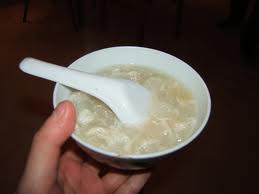Dynasty (A.D. 618-907). China is the prime consumer of a soup made
from these nests (bird's nest soup), which is considered the
"caviar of the East" until a policy of austerity under communist
rule discouraged such extravagance. Recent relaxation of controls
in the PRC has led to a surge in demand for Bird's Nest Soup.
China is importing enormous amounts of ingredients for the soup
from countries such as Malaysia and Indonesia. This is now
threatening the swift populations and has led CITES to consider
adding the bird and its nest to its lists of endangered species.
2. Description
Chinese have been eating the nest of the Swiftlet, a bird
about the size of a sparrow found in Southeast Asia and the Indian
Subcontinent, for over 1,000 years. The Edible-nest, Indian
Edible-nest and Black-nest Swiftlets weave a nest from strands of
saliva: the male regurgitates a long, thin gelatinous strand from
salivary glands under its tongue which is then wound into a half-
cup nest which bonds like quick-drying cement to the inside of a
cave wall. Swiftlet nests are (usually) carefully removed from
the cave wall. The nests are relatively tasteless and so are
usually served in soup or jelly, mixed with chicken, spices, sauce
or sweets. For centuries in China these nests have been considered
nourishing and tasty as well as a booster of health for the sick
and aging; they are even believed to be an aphrodisiac.
The harvesting of Swiftlet nests is a potentially hazardous
occupation. They are collected from high, dark caves by special
collectors who climb up and balance on bamboo poles attached to
steep cliffs. These cliffs reach hundreds of feet in height. This
is a traditional occupation and the skill of nest collection is
generally passed down from father to son.
Biochemist Kong Yun-Cheng at the Chinese University of Hong
Kong conducted a chemical analysis of the soup which revealed that
there is a water-soluble glyco-protein in the nest which promotes
cell division within the immune system. However, it is destroyed
during the cleaning process. Therefore, the soup is actually of
low nutritive value.
 |
| bird nest soup |
No comments:
Post a Comment